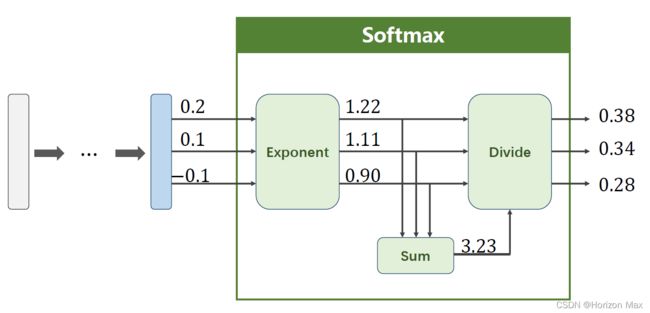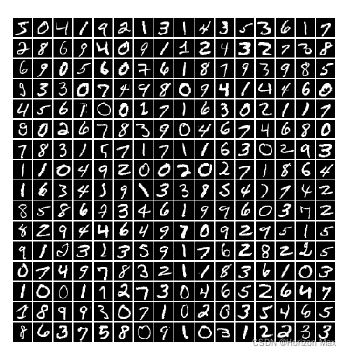PyTorch深度学习实践 Lecture09 Softmax 分类器
Author :Horizon Max
✨ 编程技巧篇:各种操作小结
机器视觉篇:会变魔术 OpenCV
深度学习篇:简单入门 PyTorch
神经网络篇:经典网络模型
算法篇:再忙也别忘了 LeetCode
视频链接:Lecture 09 Softmax_Classifier
文档资料:
//Here is the link:
课件链接:https://pan.baidu.com/s/1vZ27gKp8Pl-qICn_p2PaSw
提取码:cxe4
文章目录
- Softmax_Classifier
-
- 概述
-
- Softmax Layer
- Model
- Code
- 运行结果
- 附录:相关文档资料
Softmax_Classifier
概述
前面都在说 " 回归(regression)" 与 " 二分类(classification)" 问题;
这一篇使用 Softmax 作为分类器解决 " 多分类(classification)" 问题;
前面说到的 Logistic_Regression(逻辑斯蒂回归)使用到的是 Sigmoid 函数,可以将输出值转换到(0,1)范围:
Softmax Layer
数学表达式:

总的来说:计算每一个输出值的占比(所有输出值的对数各自 除以 他们对数的和),这样算出来的值 均为非负数 且 和为1 。
1)分子: 通过指数函数,将实数输出映射到零到正无穷;
2)分母: 将所有结果相加,进行归一化处理。
如下图所示,蓝色表示 输出值 ,中间绿色的表示 Softmax Layer ,最右边三个值为最后输出的 值 :
Logistic与Softmax比较:
1)Logistic 用于 二分类 问题,而 Softmax 用于 多分类 问题;
2)从概率角度,Softmax 属于 多项式 分布,而 Logistic 属于 伯努利 分布。
注:
CrossEntropyLoss() 交叉熵损失 函数又称 Softmax 损失函数。
使用 Sigmoid 作为激活函数时,其损失函数应设置为 binary_crossentropy()(二值交叉熵);
附:
二值交叉熵/对数表达式:

Model
这里使用的是经典数据集:MNIST DataSet
MNIST数据集是由 0 到 9 的 手写数字图像 构成;
训练集和测试集里各含名称为 0-9 的10个文件夹,共 60000张 训练集,10000 张测试集。
利用 PytTorch 搭建一个模型进行训练+测试,以下是模型结构图 :
Code
# Here is the code :
import torch
from torchvision import transforms # for constructing dataloader
from torchvision import datasets
from torch.utils.data import DataLoader
import torch.nn.functional as F # for using function relu()
import torch.optim as optim # for constructing optimizer
# 1 prepare dataset
batch_size = 64
transform = transforms.Compose([transforms.ToTensor(),
transforms.Normalize((0.1307,), (0.3081,))]) # 归一化, (均值, 方差) MINIST数据集经验值
train_dataset = datasets.MNIST(root='../dataset/mnist/', train=True, download=True, transform=transform)
train_loader = DataLoader(train_dataset, shuffle=True, batch_size=batch_size)
test_dataset = datasets.MNIST(root='../dataset/mnist/', train=False, download=True, transform=transform)
test_loader = DataLoader(test_dataset, shuffle=False, batch_size=batch_size)
# 2 design model using class
class Net(torch.nn.Module):
def __init__(self):
super(Net, self).__init__()
self.l1 = torch.nn.Linear(784, 512)
self.l2 = torch.nn.Linear(512, 256)
self.l3 = torch.nn.Linear(256, 128)
self.l4 = torch.nn.Linear(128, 64)
self.l5 = torch.nn.Linear(64, 10)
def forward(self, x):
x = x.view(-1, 784) # .viwe()中的 -1 可以自己计算值的大小
x = F.relu(self.l1(x))
x = F.relu(self.l2(x))
x = F.relu(self.l3(x))
x = F.relu(self.l4(x))
return self.l5(x) # 最后一层不做激活,不需要进行非线性变换
model = Net()
# 3 construct loss and optimizer
criterion = torch.nn.CrossEntropyLoss() # 交叉熵损失
optimizer = optim.SGD(model.parameters(), lr=0.01, momentum=0.5)
# 4 training cycle
def train(epoch):
running_loss = 0.0
for batch_idx, data in enumerate(train_loader, 0): # enumerate( , 0) 自动编号 从0开始
inputs, target = data
optimizer.zero_grad()
# forward, backward, update
outputs = model(inputs)
loss = criterion(outputs, target)
loss.backward()
optimizer.step()
running_loss += loss.item()
if batch_idx % 300 == 299:
print('[%d, %5d] loss: %.3f' % (epoch + 1, batch_idx + 1, running_loss / 300))
running_loss = 0.0
def test():
correct = 0
total = 0
with torch.no_grad():
for data in test_loader:
images, labels = data
outputs = model(images)
_, predicted = torch.max(outputs.data, dim=1) # 符号_ 可以接受返回的值,一般对于不需要用到的值可使用_, 其实也可以用字符来代替
total += labels.size(0)
correct += (predicted == labels).sum().item()
print('accuracy on test set: %d %% ' % (100 * correct / total))
if __name__ == '__main__':
for epoch in range(10):
train(epoch)
test()
函数链接: enumerate( )
运行结果
[1, 300] loss: 2.207
[1, 600] loss: 0.953
[1, 900] loss: 0.440
accuracy on test set: 89 %
[2, 300] loss: 0.325
[2, 600] loss: 0.273
[2, 900] loss: 0.236
accuracy on test set: 93 %
[3, 300] loss: 0.185
[3, 600] loss: 0.175
[3, 900] loss: 0.160
accuracy on test set: 95 %
[4, 300] loss: 0.130
[4, 600] loss: 0.121
[4, 900] loss: 0.121
accuracy on test set: 96 %
[5, 300] loss: 0.090
[5, 600] loss: 0.093
[5, 900] loss: 0.100
accuracy on test set: 96 %
[6, 300] loss: 0.075
[6, 600] loss: 0.078
[6, 900] loss: 0.074
accuracy on test set: 96 %
[7, 300] loss: 0.064
[7, 600] loss: 0.062
[7, 900] loss: 0.062
accuracy on test set: 97 %
[8, 300] loss: 0.047
[8, 600] loss: 0.052
[8, 900] loss: 0.053
accuracy on test set: 97 %
[9, 300] loss: 0.042
[9, 600] loss: 0.042
[9, 900] loss: 0.041
accuracy on test set: 97 %
[10, 300] loss: 0.030
[10, 600] loss: 0.032
[10, 900] loss: 0.036
accuracy on test set: 97 %
附录:相关文档资料
PyTorch 官方文档: PyTorch Documentation
PyTorch 中文手册: PyTorch Handbook
《PyTorch深度学习实践》系列链接:
Lecture01 Overview
Lecture02 Linear_Model
Lecture03 Gradient_Descent
Lecture04 Back_Propagation
Lecture05 Linear_Regression_with_PyTorch
Lecture06 Logistic_Regression
Lecture07 Multiple_Dimension_Input
Lecture08 Dataset_and_Dataloader
Lecture09 Softmax_Classifier
Lecture10 Basic_CNN
Lecture11 Advanced_CNN
Lecture12 Basic_RNN
Lecture13 RNN_Classifier





